PP imports and exports in 2023
I. PP import in 2023
According to customs statistics, in 2023, China imported 4.1171 million tons of PP, down 8.72% from the same period of 2022 (4.5102 million tons). Of all imports, homo PP imports totaled 2.6972 million tons, co PP 1.2731 million tons, ra co PP for 146.8kt. Import volume peaked in Feb at 392.5kt, and bottomed in Apr at 262.8kt.
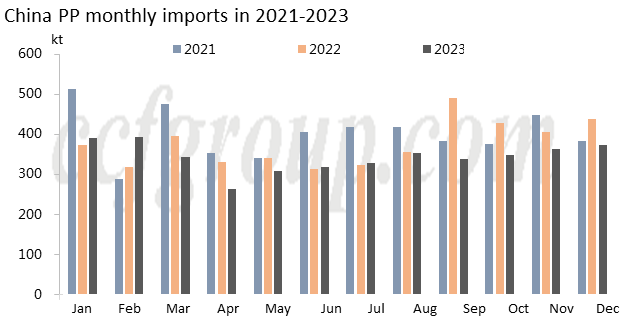
1. Homo PP import
According to customs statistics, in 2023, China imported 2.6972 million tons homo PP, down 8.02% from the same period of 2022.
|
2022 imports (KG) |
2022 trade volume (USD) |
2023 imports (KG) |
2023 trade volume (USD) |
|||
|
General trade |
1941025054 |
2309749931 |
1801787132 |
1848739836 |
||
|
Feed Processing Trade |
633954493 |
845865494 |
473420828 |
541187252 |
||
|
Customs Special Regulation Area Logistics Goods |
289388094 |
327023247 |
366866757 |
339442828 |
||
|
Processing trade |
56055368 |
63370108 |
35125477 |
39497300 |
||
|
Entry and exit goods in and out of the premises bonded |
10262931 |
14010451 |
17587968 |
19273918 |
||
|
other |
1544412 |
5006586 |
1690998 |
4747224 |
||
|
Border Trade |
/ |
/ |
710051 |
355028 |
||
|
total |
2932230352 |
3565025817 |
2697189211 |
2793243386 |
||
From the perspective of trading modes, imports of Homo PP were mainly based on general trades and feed processing trade in 2023, accounting for 66.8% and 17.55% respectively, among which, the proportion of general trade increases compared with 2022, and the proportion of feed processing trade decreases compared with 2022.
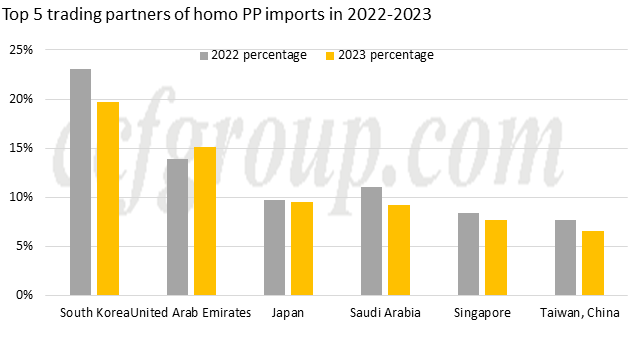
From the perspective of trading partners, imports of Homo PP in 2023 were mainly come from South Korea, the United Arab Emirates, Japan, Saudi Arabia, Singapore, China Taiwan, Thailand, Malaysia, Russia, and other countries and regions. Among them, South Korea and the United Arab Emirates remained in the top two positions, while Japan rose from fourth to third, and Saudi Arabia fell from third to fourth.
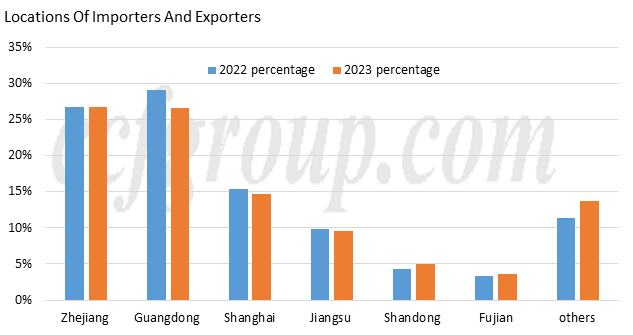
In terms of locations of importers and exporters, the corporation registered locations of Homo PP import are mainly concentrated in Guangdong, Zhejiang, Shanghai and Jiangsu and other provinces (cities), and the import share accounted for nearly 80% of the total import volume.
2. Co PP import
According to customs statistics, in 2023, China imported 1.2731 million tons of co-polymer PP, down 9.54% on the year.
|
terms of trade |
2022 imports (KG) |
2022 trade volume (USD) |
2023 imports (KG) |
2023 trade volume (USD) |
|
General trade |
1042146665 |
1.40E+09 |
937988836 |
1079271198 |
|
Feed Processing Trade |
172742685 |
227002209 |
169392711 |
191756562 |
|
Customs Special Regulation Area Logistics Goods |
145523768 |
163925867 |
138050507 |
140948009 |
|
Processing trade |
34232274 |
39077171 |
21701723 |
20397937 |
|
Entry and exit goods in and out of the premises bonded |
12580287 |
20146145 |
5881675 |
8157706 |
|
others |
98116 |
277349 |
112516 |
269754 |
|
Customs special supervision area import equipment |
13175 |
39767 |
/ |
/ |
|
total |
1407336970 |
1845000000 |
1273127968 |
1440801166 |
From the perspective of trading modes, imports of Co PP in 2023 were mainly dominated by general trade and feed processing trade. However, compared with Homo PP imports, the proportion of general trade was larger, reaching 73.68%.
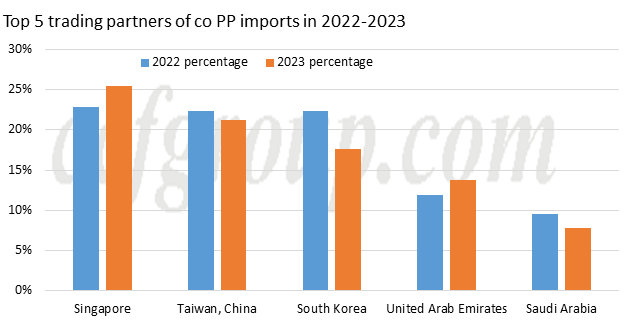
From the perspective of trading partners, imports of Co PP were mainly come from Singapore, China Taiwan, South Korea, the United Arab Emirates, Saudi Arabia, Thailand and other countries and regions, of which Singapore, China Taiwan and South Korea have been in the top three for a long time, with a total proportion of nearly 60%. Among them, South Korea fell to the third place.
3. Ra co-PP import
According to customs statistics, in 2023, China imported 146.8kt of Ra co-PP, down 7.18% on the year, and the import volume peaked in Mar and bottomed in Jun.
II. PP export in 2023
According to customs statistics, in 2023, China exported 1.3123 million tons of PP, up 3.22% from the same period of 2022 (1.2714 million tons). Of all imports, homo PP imports totaled 1.1490 million tons, co PP 135.4kt, ra co PP for 27.9kt. In Mar, PP export reached the highest single month volume at 167.9kt, and in Jan, it was the lowest at 48.2kt.
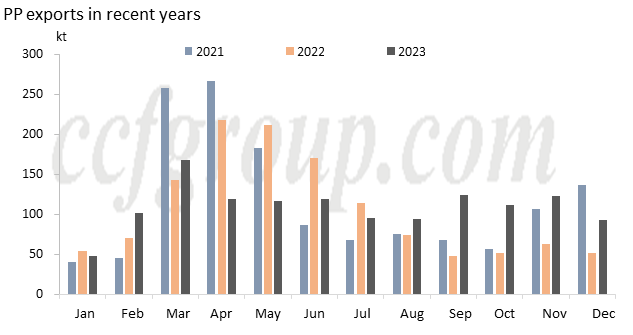
Among PP, the export volume of homo PP still accounts for a large number, while the export volume of co PP and ra PP is relatively small, and the change of the total export volume of PP is mainly reflected in the export volume of homo PP.
|
Trading partner |
Exports (KG) |
Trade volume (USD) |
Average import price (USD/ton) |
Percentage |
|
Viet Nam |
186148185 |
245704925 |
1320 |
16.20% |
|
Indonesia |
91354531 |
99066105 |
1084 |
7.95% |
|
Bangladesh |
89217612 |
90721806 |
1017 |
7.76% |
|
Brazil |
70058299 |
72488651 |
1035 |
6.10% |
|
Philippines |
61655395 |
68972552 |
1119 |
5.37% |
|
India |
60843231 |
63110836 |
1037 |
5.30% |
|
Thailand |
58971835 |
73007595 |
1238 |
5.13% |
|
Pakistan |
48702356 |
50890111 |
1045 |
4.24% |
|
Peru |
43155197 |
42482227 |
984 |
3.76% |
|
others |
438909225 |
579704471 |
1321 |
38.20% |
|
total |
1149015866 |
1386149279 |
1206 |
Taking Homo PP as an example, in terms of destination, export source of goods mainly flowed to Southeast Asia (Vietnam, Indonesia, and Philippines), South Asia (Bangladesh, India, Pakistan) and South America (Brazil, Peru). The corporation registered locations of exports were mainly concentrated in Zhejiang, Fujian and Guangdong, and the export share of the three provinces accounts for 58.15% of the total export volume, which was higher than that in 2022.
III. PP import dependence
With the release of new production capacity, China domestic production increased year-on-year. With the change in China domestic and foreign supply and demand patterns, imports decreased significantly, while exports increased. In 2023, the import dependence was only 11.21%, lower than 13.4% in the same period in 2022.
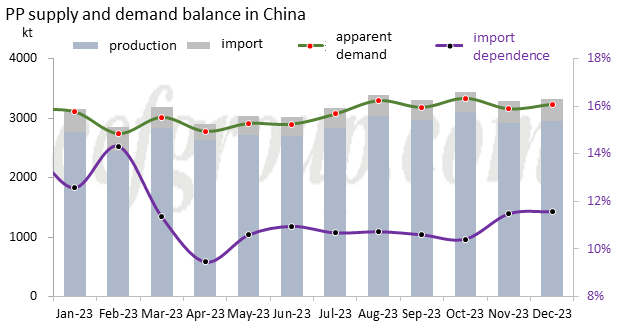
In 2024, there are still a large number of planned new startups in the domestic market. The release of new production capacity will inevitably create a new supply/demand balance. In 2024, can the overseas market be further opened up and can the import dependence of PP be further reduced while ensuring domestic demand?
- Top keywords
- Cotton Price
- Cotton Futures Price
- Cotton Futures
- CZCE
- PTA Futures Price
- Chemical Fiber
- Polyester Prices
- Wool price
- PTA Futures
- Shengze Silk
- China
- Yarn Price
- price
- China Textile City
- Fibre Price
- Benzene Price
- Cotton
- Index
- Cotton Index
- PTA
- fabric price
- NYMEX
- Top 10
- textile industry
- Spot Cotton
- Cotton Yarn
- Polyester Price
- Futures
- PTA Price
- cotton yarn price

